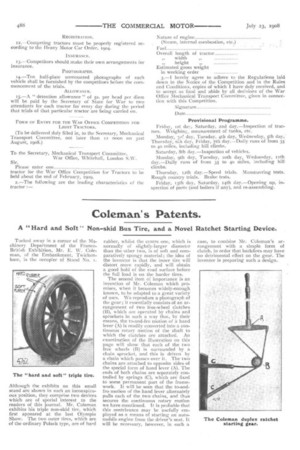Coleman' s Patents.
Page 4

If you've noticed an error in this article please click here to report it so we can fix it.
A "Hard and Soft" Non-skid Bus Tire, and a Novel Ratchet Starting Device.
Tucked away in a corner of the Machinery Department of the FrancoBritish Exhibition, Mr. E. W. Coleman, of the Embankment, Twickenham, is the occupier of Stand No. I.
Although the exhibits on this small stand are shown in such an inconspicuous position, they comprise two devices which are of special interest to the readers of this journal. Mr. Coleman exhibits his triple non-skid tire, which first appeared at the last Olympia Show. The two outer tires, which are of the ordinary Polack type, are of hard rubber, whilst the centre one, which is normally of slightly-larger diameter than the other two, is of soft and comparatively spongy material; the idea of the inventor is that the inner tire will distort more rapidly, and will obtain a good hold of the road surface before the full load is on the harder tires.
The second item of importance is an invention of Mr. Coleman which promises, when it becomes widely-enough known, to he adapted to a great variety of uses. We reproduce a photograph of the gear ; it essentially consists of an arrangement of two free-wheel clutches (B), which are operated by chains and sprockets in such a way that, by their means, the to-and-fro motion of a hand lever (A) is readily converted into a continuous rotary motion of the shaft to which the clutches are attached, An examination of the illustration on this page will show that each of the two free wheels (B) is surrounded by a chain sprocket, and this is driven by a chain which passes over it. The two chains are attached to opposite sides of the special form of hand lever (A). The -ends of both chains are separately controlled by springs (C), which are fixed to some permanent part of the framework. It will be seen that the to-andfro motion of the hand lever alternately pulls each of the two chains, and thus secures the continuous rotary motion we have mentioned. It is probable that this contrivance may be usefully employed as a means of starting an automobile engine from the driver's seat. It will be necessary, however, in such a case, to combine Mr. Coleman's arrangement with a simple form of clutch, in order that backfires may have no detrimental effect on the gear. The inventor is preparing such a design.




















